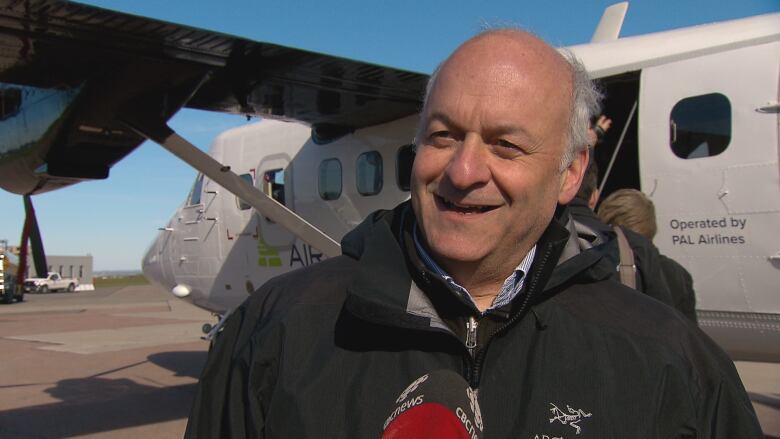Spotting whales from 240 metres like finding 'a needle in a haystack'
Scientists fly over Gulf of St. Lawrence and Bay of Fundy daily in search of endangered right whales

With 460,000 square kilometres of ocean to survey, and only about 450 North Atlantic right whales left in the world, the people trying to spot the endangered giants from airplanes this summer have a very tough assignment.
Jean-FranoisGosselin, a biologist with the Department of Fisheries and Oceans, is co-ordinating the marine mammal aerial surveillance program for DFO and Transport Canada.
So far 27 right whales have been spotted from the skies.
This data is the main tool for managers at the federal departments whomake the decisions about closing fishing areas and reducing speed limits in shipping lanes in the continuing effort to protect the whales.
'We try to keep emotion out of it'
Five planes, some makingdaily flights, are surveying the Gulf of St. Lawrence, Bay of Fundy, ScotianShelf and the southern coast of Newfoundland.

"All the planes are flying at low levels between 1,500 and 800 feet," Gosselin said. "The detection of whales is done visually by marine mammal observers that got training before the fishing season opened."
In addition to the eyeballs of the observers, who are looking for the "V-shaped blows" of right whales, some of the planes alsohave cameras.
It's like looking for a needle in a haystack and to make it more efficient we're trying to concentrate our effort where we expect the whales will be.- Jean-FranoisGosselin
"The fisheries surveillance planes are equipped with high-power magnification cameras that can help detect the animals," Gosselin said.
"But they can also take photographs of the animals to identify them to make sure they're right whales."
When a North Atlantic right whale is seen, Gosselin and the observers "try to keep the emotion out of it."
"When you're in the plane you have toforgettheseemotionsand make sure you're objective and keeping with theobjectivesof the work you're doing," he said.
"It's always sad to have an endangered species, but to make the decisions to protectthose animals we have to make sure we're collecting the bestinformationpossibleto make the best decision you can make."
Using past data to improve odds
The first North Atlantic right whale of this season was spotted on the ScotianShelf on May 15, and the first right whale in the Gulf of St. Lawrence was seen May 19.
"We're looking for animals for which the population has been estimated in 2016 at 458 animals so we're looking for ... one animal per 1,000 square kilometres," Gosselinsaid.
Twelve whales have been killed in Canadian waters alone since the beginning of last year, with the blame going to ship strikes or entanglement in fishing gear.
The spotting of 27 whales in the region this yearhas led to the closure of severalfishing areas off northeastern New Brunswick, the latest of which goes into effect on Wednesday,
- Presence of right whales leads to more fishery closures
- 'That area is not well-known': Scientist says restrictions in Gulf could ease over time
"As soon as we spot a right whale the information is transmitted to the situation centre of Transport Canada, which then relays the information to the Fisheries and Oceans managers."
Gosselin said observers are using past data, collected by hydrophones mounted on buoys throughout the Gulf of St. Lawrence and along the Atlantic coast, to help them in their daily search.

"It's like looking for a needle in a haystack and to make it more efficient we're trying to concentrate our effort where we expect the whales will be, and to do that we're looking at areas where whales have been detected in the past."
The surveillance flights will continue until the whales leave the region, which is usually in November but could be as late as January.
"This information will be gathered at the end of the summer to better understand theseasonaldistributionof the whales throughout the Canadian waters and hopefullyimproveour management measures over the next year and the coming years," Gosselinsaid.
Other projects planned for the summer include placing satellite transmitters on North Atlantic right whales.
Gosselin said that has proven successful for blue whales, but keeping the transmitters on a right whale is much more difficult.
"The problem with right whales is they tend to roll over themselves in social groups and there have been similar instrumentsdeployed on the East Coastand they only last about a couple of weeks."
With files from Gabrielle Fahmy and Information Morning Moncton













_(720p).jpg)


 OFFICIAL HD MUSIC VIDEO.jpg)
.jpg)



























































































